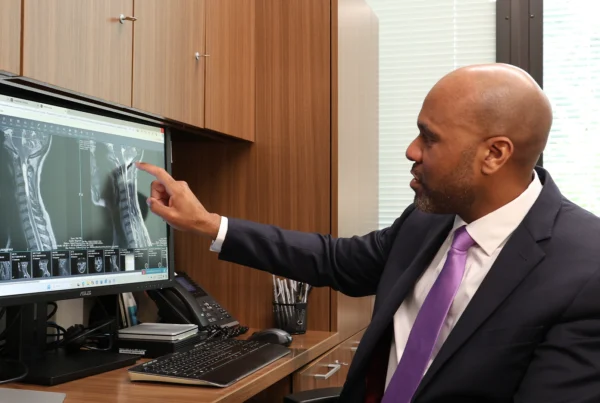Preparing for a blood clot in brain surgery recovery will help you know what to expect during that time, freeing you to focus on the healing process. Though your individual recovery will be a personal experience, having a general idea of what to expect following your procedure can help set your mind at ease as your treatment date approaches.
The following information is designed to help you learn more about your condition and a blood clot in brain surgery recovery. Specifically, the information below covers subdural hematomas, which is the most common type of blood clot. This will give you a good jumping-off point to continue the discussion with your personal doctor about your specific recovery process.
About Blood Clots in the Brain
A blood clot in the brain is also called a hematoma. You may have come across this term as you are learning more about your condition, especially a particular type called a subdural hematoma. A subdural hematoma occurs when there is bleeding between the brain and the thin membrane covering it, the dura.
A blood clot in the brain is typically the result of trauma, which can be either a single significant episode or repeated minor injuries. The chance of a blood clot in the brain increases with age. This is because the brain shrinks over time, but the skull remains the same size. Think of this as creating a space around the brain, with room to jostle around. This can lead to tears in delicate blood vessels and bleeding, followed by clotting. The risk increases with age naturally, as well as factors that increase bleeding, such as anticoagulant medications and excessive alcohol intake.
Surgery for Blood Clot in the Brain
When there is a subdural hematoma in the brain, it can press on the delicate tissue of the brain, leading to damage and/or symptoms. This is one reason it is important to undergo treatment and prevent further complications. Generally speaking, there are two surgical treatment options to remove the blood clot: burr hole drainage and craniotomy.
During burr hole drainage, the neurosurgeon will create one or two small holes within the skull, followed by an incision in the dura if necessary, in order to drain the blood clot. Following surgery, the incision area is closed up using sutures. The holes will be as few and as small as possible.
However, the surgeon may need larger access to the blood clot, requiring a different procedure called a craniotomy. During a craniotomy, the neurosurgeon will remove a section of bone to create access, then remove the blood clot. When the procedure is complete, the surgeon will replace the section of bone and close up the soft tissue using sutures or staples.
We are more than surgeons,
we are your support system.
Blood Clot in Brain Surgery Recovery
Again, your blood clot in brain surgery recovery is going to depend on your personal health factors, such as the reason for your blood clot and complicating health conditions you may have. However, it can be helpful to understand on a broad level what you can expect following either burr hole drainage surgery or a craniotomy for your subdural hematoma. This will help you as you continue the discussion about your personal doctor about your individual case.
Following burr hole drainage surgery, most patients will spend at least two to three days recovering in the hospital. Immediately following surgery, you will leave the OR to recover in a recovery room for a short period of time. You will then go to the ICU for a day or two. Once you are deemed stable, you will be transferred to a regular floor to recover until you are discharged. During recovery, you will likely feel tired and may experience headaches. Your doctor can prescribe you medications to ease any discomfort during this period. As you begin your recovery at home, you will be on activity restrictions for at least a few weeks, including restrictions on lifting and exercise.
If you undergo a craniotomy, your recovery may be longer due to the more invasive nature of the procedure. However, the overall flow is the same. Most patients spend three to four days recovering in the hospital before beginning recovery at home, which can last up to 12 weeks. Again, there will be restrictions on certain activities, such as driving and chores, which your doctor will gradually lift as your body heals.
Your Personal Recovery
Now that you have an increased understanding of blood clot in brain surgery recovery and the treatment options available, continue the discussion with your own doctor about expectations following your procedure. It is important to keep in mind that there may be aspects of your recovery specific to any damage that has occurred to the brain as a result of the blood clot, and your personal doctor will be the best person to discuss the specifics of your condition with you.
As you move forward through the treatment process, continue to educate yourself about your condition and upcoming treatment. Taking an active part in your treatment and recovery is an empowering way to have confidence throughout the process, giving you peace of mind along the way. If you still have any questions about what to expect during your personal recovery, be sure to bring them up with your doctor at your next appointment. He or she will be happy to take the time to ensure you are comfortable with all aspects of your treatment path.

About Dr. Paul R. Gigante
Dr. Paul Gigante is an accomplished neurosurgeon in Central Jersey and a proud member of Neurosurgeons of New Jersey, practicing out of their Livingston office located conveniently on South Orange Avenue. He is recognized as a leading spine surgeon for both minimally invasive and complex procedures. Dr. Gigante is a graduate of Harvard Medical School and completed his fellowship at Stanford University in functional neurosurgery. His specialties are deep brain stimulation for Parkinson’s Disease and other nervous system disorders, spinal cord stimulation for chronic pain disorders, and surgical treatments for chronic nerve pain conditions. He also specializes in brain tumor surgeries. Dr. Paul Gigante is currently accepting new patients.






